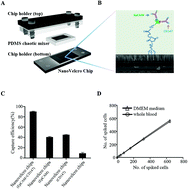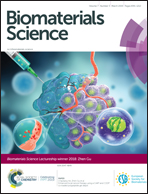The role of a semi-automated NanoVelcro system in capturing circulating tumor cells and evaluating their prognostic value for gestational choriocarcinoma†
Abstract
To investigate whether circulating tumor cells (CTCs) are detectable in patients with gestational choriocarcinoma (GC) and evaluate the prognostic value of CTC enumeration. In this multicenter study, the presence of CTCs was examined in 180 GC patients using a semi-automated NanoVelcro system, among whom 106 patients underwent CTC re-evaluation after one cycle of chemotherapy. Approximately 96% of the GC patients contained ≥2 CTCs in 7.5 mL of blood. The number of CTCs per 7.5 mL of blood was much higher in patients with distant metastases (n = 95; range, 0 to 104) than in patients without distant metastases (n = 85; range, 0 to 6). Applying a 90-patient training and 90-patient validation cohort, a cutoff value of ≥6 CTCs was defined as the prognostic threshold for progression-free survival (PFS) and overall survival (OS). The presence of ≥6 CTCs was significantly associated with worse PFS and OS (both P < 0.001). A multivariate analysis showed that the CTC number (≥6 CTCs) was the strongest predictor of OS (hazard ratio [HR], 15.8; 95% confidence interval [CI], 4.3–57.9; P < 0.001). The number of CTCs decreased after one cycle of chemotherapy; univariate analyses demonstrated that the CTC count after the first chemotherapy cycle was a strong predictor of OS (HR, 36.1; 95% CI, 4.8–271.5; P < 0.001). CTCs are a promising prognostic factor for GC. The absolute CTC count after one cycle of chemotherapy in the context of this disease is a strong predictor of chemotherapy response.



 Please wait while we load your content...
Please wait while we load your content...